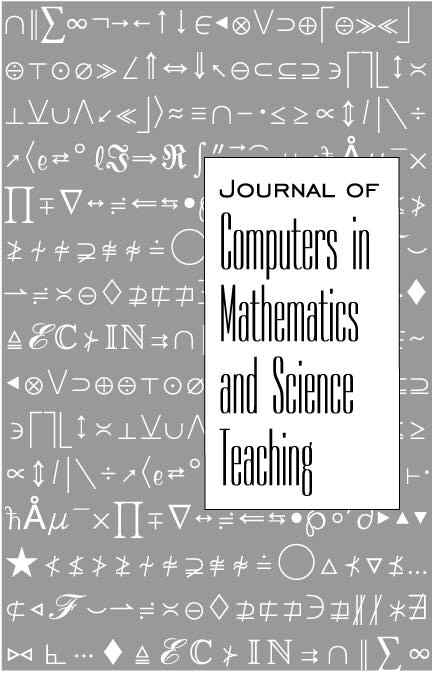
Under the Microscope: Factors Influencing Student Outcomes in a Computer Integrated Classroom
Article
YOVAN ESHET, JOEL KLEMES, LYN HENDERSON, James Cook University, Australia
JCMST Volume 19, Number 3, ISSN 0731-9258 Publisher: Association for the Advancement of Computing in Education (AACE), Waynesville, NC USA
Abstract
Researchers continue to argue that more research is needed con-cerning how teachers actually integrate instructional technology into their curriculum. This qualitative study examined the incor-poration of interactive multimedia science software into a grade two classroom over a six-week period. There was growth in vari-ous social and thinking skills that were developed and reinforced within the computer-supported learning environment. Several factors that contributed to these outcomes are identified: the software's instructional design, enthusiasm, on-task behavior, cooperation and collaboration among the students, improved cognitive learning outcomes, attitudes toward science, the teach-er's pedagogical approach and attitudes toward incorporating technology into the curriculum, and an integrated curriculum. In addition, the results indicated increased positive attitudes to-wards science by the girls after using the software. Implications for computer integration are provided.
Citation
ESHET, Y., KLEMES, J. & HENDERSON, L. (2000). Under the Microscope: Factors Influencing Student Outcomes in a Computer Integrated Classroom. Journal of Computers in Mathematics and Science Teaching, 19(3), 211-236. Charlottesville, VA: Association for the Advancement of Computing in Education (AACE). Retrieved August 12, 2024 from https://www.learntechlib.org/primary/p/8070/.
© 2000 Association for the Advancement of Computing in Education (AACE)
Keywords
References
View References & Citations Map- Bennet, N., & Dunne, E. (1991). The nature and quality of talk in cooperative classroom groups. Learning and Instruction, 1(2), 103-118.
- Brown, J., Collins, A., & Duguid, S. (1989). Situated cognition and the culture of learning. Educational Researcher, 18(1), 32-42.
- Brush, T. (1997) The effects of group composition on achievement and time on
- Drazdowski, T.A. (1997). Multimedia in teacher education: A small college approach. [CD-ROM]. Paper presented at ED-MEDIA 97, Calgary, June 1016.
- Ellsworth, J. (1994). Education on the Internet. Indianapolis, IN: Sam ’s Publishing.
- Gallimore, R., & Tharp, R. (1990). Teaching mind in society: Teaching, schooling, and literate discourse. In L. Moll (Ed.), Vygotsky and education: Instructional implications and applications of sociohistorical psychology (pp. 175-205). Cambridge: Cambridge University Press.
- Glenna, T.K., & Melmed, A. (1996). Fostering the use of educational technology: Elements of a national strategy . A Rand Report. Santa Monica , CA:
- Gregoire, R., Bracewell, R., & Laferriere, T. (1996). The contribution of new technologies to learning and teaching in elementary and secondary schools.
- Haugland, S., & Wright, J. (1997). Young children and technology: A world of discovery. Boston: Allyn and Bacon.
- Henderson, L. (1996). Instructional design of interactive multimedia: A cultural critique. Educational Technology Research & Development, 44(4), pp.85-104.
- Howland, J., Laffey, J., & Espinosa, L. (1997). A computing experience to motivate children to complex performances. Journal of Computing in Childhood Education, 8(4), 291-313.
- Inkpen, K. (1997). Three important research agendas for educational multimedia:
- Inkpen, K., Booth, K., Gribble, S., & Klawe, M. (1995). Give and take: Children ’s collaboration on one computer. Proceedings of CHI ’95, Conference Companion (pp. 258-259). ACM Press.
- Jonassen, D. (1996). Computers in the Classroom. New York: Prentice-Hall.
- Johnson, D., & Johnson, R. (1985) Co-operative learning: One key to computer assisted learning. The Computing Teacher, 13(2), 11-14.
- Levine, T. (1994). A computer-based program can make a difference: The case of the rediscover science program. Studies in Education Evaluation 20(4), 293-296.
- Maddux, C., Johnson, D., & Willis, J. (1997). Educational computing: Learning with tomorrow ’s technologies . Boston: Allyn & Bacon.
- McLellan, H. (1994). Interactions of student partners in a high school astronomy computer lab. Computers in the Schools, 11(1), 30-41.
- Nastasi, B., & Clements, D. (1993). Motivational and social outcome of cooperative computer education environments. Journal of Computing in Childhood Education, 4(1) 15-43.
- Norman, D. (1993). Things that make us smart. Reading, MA: Addison-Wesley.
- Papert, S. (1993). The children ’s machine: Rethinking school in the age of the computer. New York:Basic Books.
- Reeves, T. (1993). Research support for interactive multimedia: Existing foundations and new directions. In C. Latchem, J. Williamson, & L. HendersonLancett (Eds.), Interactive multimedia: Practice and promise (pp. 79-96). London: Kogan Page.
- Reeves, T. (1997). Pseudoscience in qualitative research. [Online]. Available: ITFORUM listserv. Access date: March 17.
- Rieber, L. (1996). Seriously considering play: Designing interactive learning environments based on the blending of microworlds, simulations, and games. Educational Technology Research & Development, 44(2), 43-58.
- Rowe, H. (1993). Learning with personal computers. Hawthorn, Vic: Australian Council for Educational Research.
- Salomon, G. (1998). Novel constructivist learning environments: Some issues to be concerned with. Paper presented at Thinking in Teaching and Learning Conference, Jerusalem, January, 5-6.
- Selwyn, N. (1997). The continuing weaknesses of educational computing research. British Journal of Educational Technology, 28(4), 305-307.
- Shapiro, B. (1994). What children bring to light: A constructivist perspective on children’s learning in science . Columbia: Teachers College Press
- Slavin, R. (1996). Research on cooperative learning and achievement: What we know, what we need to know. Contemporary Educational Psychology, 21 , 43-69.
- Temple, C. (1997). Developmental cognitive neuropsychology. Hove, UK: Psychology Press.
- Thurman, R. (1993). Instructional simulation from a cognitive psychology viewpoint. Educational Technology Research & Development, 41(4), 75-79.
- Upitis, R., & Koch, C. (1996). Is equal computer time fair for girls? Potential Internet inequities. Paper presented at 6th Annual Conference of the Internet Society, INET ’96, Montreal.
- U.S. Congress Office of Technology Assessment. (1995). Teachers and technology: Making the connections. OTA-HER-616. Washington: US Government Printing Office.
- Wild, M., & Braid, P. (1997). A model for measuring children ’s interactions in small groups. Journal of Computing in Childhood Education, 8(2/3), 215-225.
These references have been extracted automatically and may have some errors. Signed in users can suggest corrections to these mistakes.
Suggest Corrections to References